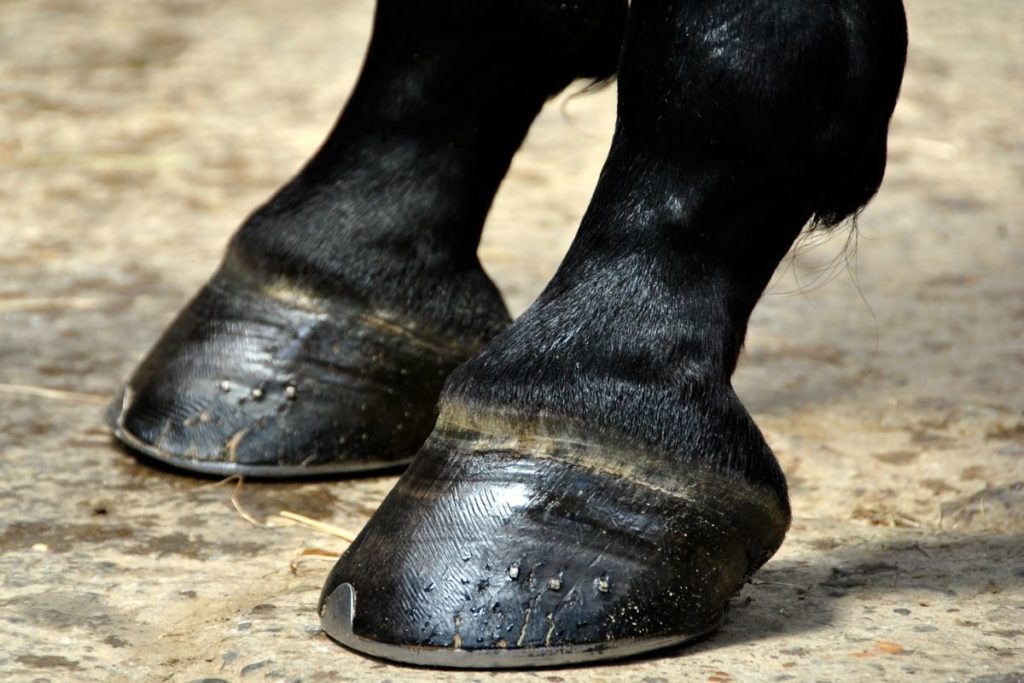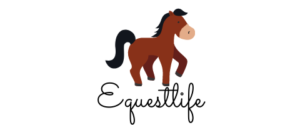Just like your nails, a horse’s hooves need regular trimming to stay healthy. Trimming hooves is not just about aesthetics. Properly trimmed hooves prevent many hoof and leg problems. For these reasons, a regular schedule of hoof maintenance is a must for any horse owner. But how often should your trim your horse’s feet?
Most vets and farriers suggest that an unshod horse has its hooves trimmed and checked every 6 to 10 weeks. Routinely shod horses need their hooves and shoes tended to every 4 to 6 weeks for good health.
Several factors contribute to scheduling a farrier to trim and inspect your horse’s hooves. These factors apply to horses who go unshod and shod horses. We’ll help you understand the factors contributing to your horse’s foot health and what is key to making wise decisions about the scheduling.
The Big Difference – Shod or Unshod?
Hoof care for unshod horses is different than for horses who are kept shod. Horses who don’t wear shoes require different hoof care schedules and present different wear patterns that should be understood. There are many factors to consider when deciding on a hoof maintenance schedule.
- Seasonal Variations
- Terrain and Conditions
- Your Horses Health
- Movement and Activity
What Happens if you Don’t Trim a Horses’ Hooves?
If your horses’ hooves go untrimmed, they continue to grow. Horses’ stabled continuously can’t self-trim their hooves running or walking. In extreme cases, a horse’s hooves may grow and curl so badly that the horse can no longer walk. Untrimmed hooves can be a deadly situation.
- Overgrowth can allow infections that lead to more serious problems.
- Unrepairable damage to the internal structure of the hoof may occur
- Remodeling of the bones in the feet and ankles is not uncommon
- The misshapen hoof doesn’t allow the horse to walk properly
Unshod Horses – Schedules and Care
If the situation is right, keeping your horse unshod may be the best option for general good hoof health. Many factors contribute to this decision. Some of the more important include
- What is the terrain your horse inhabits? – Many horse owners must stable their horse. If a horse gets infrequent use and doesn’t have a large and open expanse to exercise, the time between farrier visits is usually shorter. Wild horses or those kept pastured in large areas wear their hooves down naturally and don’t require direct attention as often.
- How about nutrition and health? – Your horses’ diet can make a big difference in hoof health, translating into less frequent visits from the farrier. Studies have shown that high-quality feed can help many hoof problems.
- Seasonal concerns – The time of year can contribute to trimming and caring for your horse’s hooves. Horses hooves tend to grow faster in the summer than in the winter and your hoof maintenance schedule should reflect this change.
- How often do you ride? – Stabled horses need regular exercise, and the best exercise is riding. A regular riding pattern wears down the hooves of an unshod horse and can lengthen the time between farrier visits.
The Importance of Trimming Unshod Hooves
As a horse’s hooves grow, the weight distribution and angle that the hoof presents to the ground can change as well. Improperly trimmed hooves don’t provide the proper presentation and cause a host of problems with your horse.
- Keeping a straight hoof-pastern angle can help keep the bones in the horse’s feet and legs aligned for proper support.
- Proper toe formation allows your horse to move easier without excessive break over.
- Balanced hooves make lateral support equal as the horse walks.
- The entire leg is supported when hooves are properly trimmed and balanced.
Scheduling for Good Hoof Health
Typically, an unshod horse should have its hooves trimmed every 6 to 10 weeks. In winter, the length of time between visits with the farrier may be longer. In summer, you may need to shorten the time between hoof trimming and care.
The best advice will come from your farrier. As he gets to know and understand your horse, he will learn your horse’s characteristic hoof growth and patterns. Your farrier can make recommendations on scheduling and care needs for your horse’s hooves based on that knowledge.
Shod Horses – Keeping Those Shoes in Top Condition

Many horse owners prefer to keep their horses shoed. There are many reasons for shoeing horses, mostly due to poor conformation or hoof problems. These reasons can include;
- Hoof Durability – Most working horses are kept in shoes to help the durability of their hooves. The keratin that makes up your horse’s hooves is relatively soft and easily wears away. Horseshoes help keep this wear to a minimum and protect the other parts of the horse’s foot.
- Trail Ride Protection – Horses used for trail riding or on hard surfaces such as streets or sidewalks need additional protection for their hooves. Preventing abnormal wear and giving the horse a better grip when walking can make riding much safer.
- Prevention and Correction – A good farrier can design and apply horseshoes that correct such imperfections as uneven wear, limb deviations, and conformation faults.
It is vital to your horse’s health and well-being that the horseshoes are in top condition with properly trimmed hooves.
The Importance of Trimming and Shoeing Regularly
Horses’ hooves grow continually. As the hooves grow, they get wider and longer. A horse’s hoof that has a shoe prevents the hoof from expanding. The eventual result of this restricted growth is to put more of the horse’s weight on the outside of the hoof, causing the horse to become lame.
Properly fitted shoes on a horse’s hoof offer additional protection from bruising and cracking. If you routinely trail ride or compete in jumping competitions, properly fitted and applied horseshoes are a must.
How Often Should My Horse be Re-Shod?
The scheduling of re-showing and hoof inspection has a lot to do with how often you ride or compete with your horse. Typically, a shod horse should have a visit from the farrier every 4 – 6 weeks.
- If you ride a lot or compete regularly, the time between the farrier visits will probably be closer to the schedule’s four-week end.
- Normal growth rates require a visit from an inspection and reshoeing no less than every six weeks.
- Seasonal changes in hoof growth can change this schedule from summer to winter.
Just like an unshod horse, as your farrier learns your horse, his or her advice will become invaluable when making your hoof care schedule.
What Should I Look for to Know if my Horse Needs Hoof Care?
As you spend time with your horse, you will begin to learn how to judge if there are problems or just time for a hoof trim. Your farrier can teach you a lot. In general, you should watch these things about your horse.
- Inspect your horse’s feet regularly and look for damage, cracks, or other problems.
- Check the toe of your horse’s hoof. It should be almost circular. If the toes look longer or oval, the hoof probably needs to be trimmed.
- Look for the uniform length of the hoof. The distance between the toed and the coronet band on the hoof should be equal.
- A hoof in need of trimming may have an incorrect angle. The angle of the coronet band with the horse’s elbow should describe a straight line.
- Any sign of lameness or a horse who favors one leg should be an immediate indication that there may be a problem with a hoof or a shoe.
Does it Hurt Horses to Cut Their Hooves?
Horse’s hooves are much the same material as your fingernails. Like your fingernails, they grow continuously. There are no nerve endings in the hooves themselves. When properly trimmed, the horse feels no pain at all.
However, trimming too aggressively or improperly trimming can leave your horse tender footed several days after a trim. Watch your horse carefully. What may seem like a tenderfoot may be an abscess or other problem.
How Much Does it Cost to Trim a Horses’ Hooves?
Farrier services vary widely around the country. The skill and reputation of the farrier also affect the cost. Average costs of farrier services typically are:
- $25 to $30 per horse to trim hooves.
- Shoeing and trimming averages $125 to $150 per horse.
- Corrective custom shoeing and trimming usually start at about $150 per horse and can go much higher depending on the problem’s severity.
Your Horse Depends on You
Your horse depends on you to make judgments and decisions that keep it healthy. Routine care is part of the responsibility that you have for your horse. Foot care is one of the most important aspects of keeping your horse healthy. A routine trimming schedule is vital, as is proper and regular shoeing if that is your choice.
Don’t neglect your horse’s hooves, and your horse will repay you with many years of companionship and enjoyment. Set up a schedule with your farrier for a year-round hoof and foot care regimen. Go take a ride. Both you and your horse will benefit from it.
